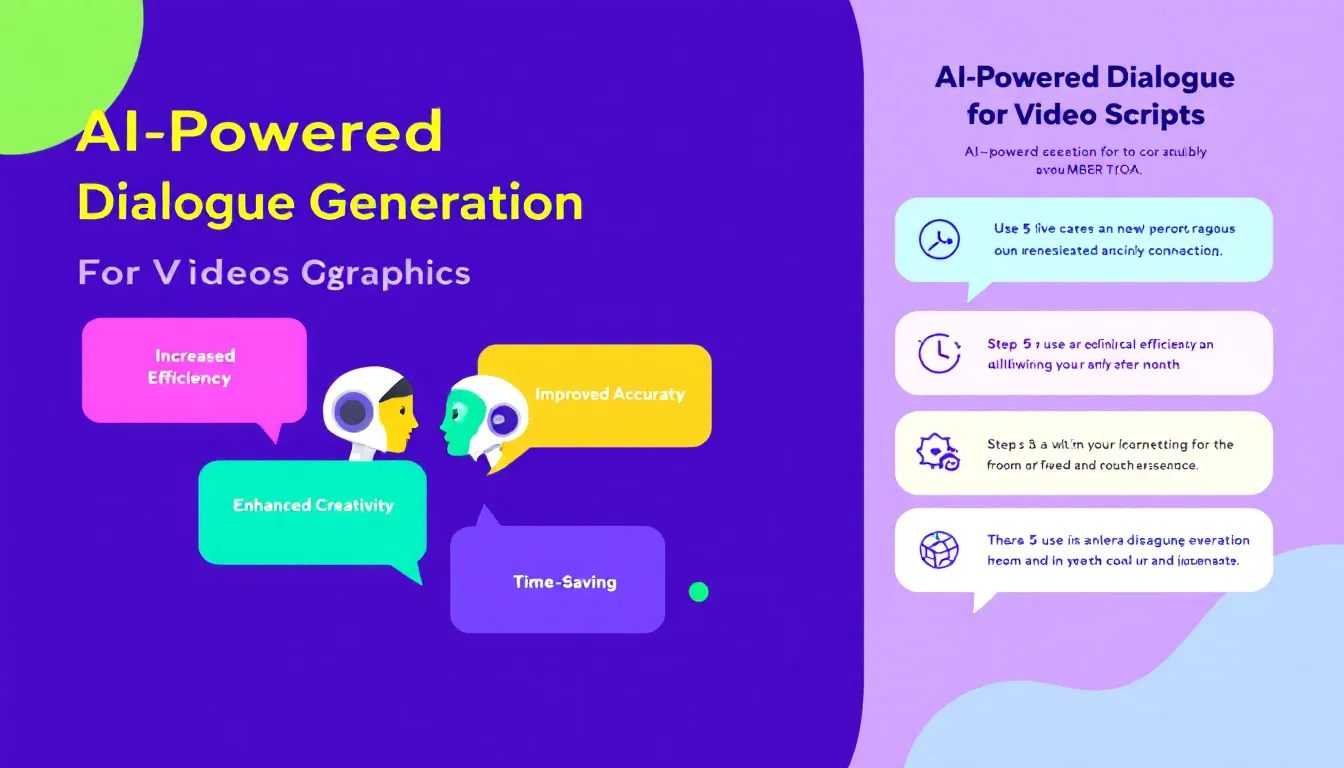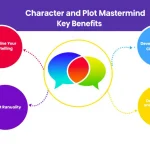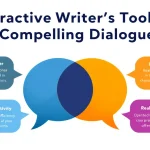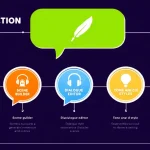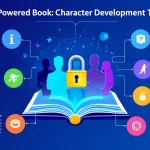Is this tool helpful?
How to Use the Dialogue Generation Tool Effectively
Our Dialogue Generation Tool is designed to help video script writers create engaging and realistic conversations between characters. Here’s a step-by-step guide on how to use this tool effectively:
- Characters: In the first field, list the characters involved in the dialogue. Include brief descriptions of their personalities or roles. For example:
- Emma: A passionate environmental activist with a fiery temper
- Dr. Marcus: A skeptical climate scientist nearing retirement
- Topic: Enter the main subject of the dialogue. For instance: “The impact of ocean acidification on marine ecosystems”
- Plot Context (Optional): Provide a brief description of the setting or background for the dialogue. Example: “A heated debate at an international climate conference in Geneva”
- Dialogue Length: Specify the desired length of the dialogue. This could be in terms of exchanges, word count, or duration. For example: “8 exchanges” or “500 words”
- Generate Dialogue: Click the “Generate Dialogue” button to create your custom conversation
- Review and Copy: Once generated, review the dialogue in the result section. If satisfied, use the “Copy to Clipboard” button to easily transfer the text to your preferred writing software
By providing detailed information in each field, you’ll receive a more tailored and relevant dialogue that aligns with your script’s needs.
Revolutionizing Script Writing: The Power of AI-Driven Dialogue Generation
In the fast-paced world of video production and scriptwriting, creating engaging, authentic dialogue can be a time-consuming and challenging task. Our Dialogue Generation Tool harnesses the power of artificial intelligence to streamline this process, offering writers a powerful ally in their creative endeavors.
This innovative tool is designed to generate captivating and realistic conversations between characters based on user-provided inputs. By analyzing the given characters, topic, and context, the AI crafts dialogue that not only sounds natural but also contributes to character development and plot progression.
The Science Behind AI-Generated Dialogue
At the core of our Dialogue Generation Tool lies advanced natural language processing (NLP) algorithms. These algorithms are trained on vast datasets of human conversations, literary works, and screenplays, enabling them to understand and mimic the nuances of human dialogue.
The tool employs a combination of techniques, including:
- Contextual understanding: Analyzing the given topic and plot context to generate relevant content
- Character personality modeling: Creating distinct voices for each character based on their descriptions
- Dialogue flow optimization: Ensuring a natural progression of conversation with appropriate pacing
- Emotional intelligence: Incorporating appropriate emotional responses and subtext
Benefits of Using the Dialogue Generation Tool
Integrating our AI-powered Dialogue Generation Tool into your scriptwriting process offers numerous advantages:
- Time-saving: Rapidly generate initial drafts of dialogue, allowing writers to focus on refining and polishing rather than starting from scratch
- Overcoming writer’s block: Provides a starting point when you’re stuck, offering fresh ideas and perspectives
- Character consistency: Helps maintain consistent character voices throughout your script
- Exploration of different scenarios: Quickly generate alternative versions of a conversation to explore various narrative possibilities
- Learning tool: Observe AI-generated dialogue to gain insights into effective conversation structuring and character interactions
- Increased productivity: Streamline your writing process, potentially allowing you to take on more projects or meet tighter deadlines
- Creativity boost: Spark new ideas and directions for your story through unexpected dialogue turns
- Accessibility: Provides assistance to writers of all skill levels, from novices to seasoned professionals
Addressing User Needs: How the Dialogue Generation Tool Solves Specific Problems
Our Dialogue Generation Tool is designed to address common challenges faced by video script writers and content creators. Let’s explore how this tool tackles specific problems:
1. Overcoming Creative Blocks
Many writers struggle with creative blocks, especially when it comes to dialogue. Our tool provides a solution by offering a starting point for conversations between characters. By generating initial dialogue based on your inputs, it helps kickstart your creative process and overcome mental barriers.
2. Maintaining Character Consistency
Keeping characters’ voices consistent throughout a script can be challenging, especially for projects with multiple characters or lengthy scripts. The Dialogue Generation Tool analyzes character descriptions and creates dialogue that aligns with their personalities, helping maintain consistency in their speech patterns and mannerisms.
3. Exploring Different Narrative Directions
Writers often want to explore various ways a conversation could unfold but may find it time-consuming to write multiple versions. Our tool allows you to quickly generate different dialogue options for the same scenario, enabling you to compare and choose the most effective direction for your story.
4. Enhancing Dialogue Realism
Creating natural-sounding dialogue that reflects real-world conversations can be challenging. The AI behind our tool has been trained on extensive datasets of human interactions, allowing it to generate dialogue that sounds authentic and relatable to audiences.
5. Addressing Time Constraints
In the fast-paced world of video production, writers often face tight deadlines. The Dialogue Generation Tool significantly reduces the time needed to create initial drafts of conversations, allowing writers to meet deadlines more comfortably and focus on refining the generated content.
6. Providing Inspiration for Character Development
Sometimes, writers struggle to fully flesh out their characters through dialogue. By generating conversations based on character descriptions, our tool can provide new insights and ideas for character development, helping writers create more complex and interesting personalities.
Practical Applications: Examples of the Dialogue Generation Tool in Action
To illustrate the versatility and effectiveness of our Dialogue Generation Tool, let’s explore some practical examples across various genres and scenarios:
Example 1: Crime Drama
Characters:
- Detective Sarah Hawkins: A seasoned investigator with a sharp mind and dry wit
- Officer Jake Rivera: A rookie cop eager to prove himself
Topic: Investigating a mysterious break-in at the city museum
Plot Context: Late-night at the crime scene, surrounded by shattered glass and priceless artifacts
Generated Dialogue:
Sarah: “Well, rookie, what do you make of this mess?”
Jake: “It looks like a standard break-in, Detective. Probably some kids looking for a thrill.”
Sarah: (chuckling dryly) “Standard? Take a closer look, Rivera. Notice anything odd about that shattered display case?”
Jake: (frowning, moving closer) “I… wait a minute. The glass is on the outside of the case, not inside. That’s not right, is it?”
Sarah: “Bingo. Someone wants us to think this was a break-in. But whoever did this was already inside the museum.”
Jake: (eyes widening) “An inside job? But who would have access and the expertise to pull this off?”
Sarah: (smirking) “That, Officer Rivera, is exactly what we’re going to find out. Welcome to the world of real detective work.”
Example 2: Sci-Fi Adventure
Characters:
- Captain Zara Vex: A battle-hardened space explorer with a mysterious past
- AI-N1X: The ship’s artificial intelligence, logical but learning to understand human emotions
Topic: Deciding whether to explore an uncharted planet emitting strange energy signatures
Plot Context: On the bridge of the starship Nebula Seeker, facing a swirling, purple planet on the main viewscreen
Generated Dialogue:
Zara: “AI-N1X, what’s your analysis of that energy signature?”
AI-N1X: “Captain, the readings are unlike anything in our database. The energy patterns defy known laws of physics.”
Zara: (leaning forward, eyes gleaming) “Sounds like we’ve stumbled onto something big.”
AI-N1X: “Caution is advised, Captain. The unknown variables present a 78.3% risk to the ship and crew.”
Zara: “Sometimes, N1X, the greatest discoveries come with the biggest risks.”
AI-N1X: “I do not understand, Captain. Is the potential for discovery worth jeopardizing our safety?”
Zara: (smiling) “That’s what makes us human, N1X. Our curiosity often outweighs our fear. Plot a course for the planet’s orbit. Let’s make history.”
AI-N1X: “Course plotted, Captain. I will continue to monitor for any changes in the energy signature. And… good luck.”
Zara: (raising an eyebrow) “Was that concern I heard in your voice, N1X?”
AI-N1X: “Merely an observation of human customs, Captain. Shall we proceed?”
Example 3: Romantic Comedy
Characters:
- Alex: A charming but clumsy coffee shop owner
- Morgan: A high-powered lawyer with a secret soft spot for rom-coms
Topic: A chance meeting after Alex accidentally spills coffee on Morgan’s expensive suit
Plot Context: During the morning rush at Alex’s cozy but chaotic coffee shop
Generated Dialogue:
Alex: “Oh no, oh no, oh no! I’m so incredibly sorry! Let me get you some napkins, or a towel, or maybe a new suit?”
Morgan: (looking down at the growing stain, then up at Alex with a mix of frustration and amusement) “Well, this is certainly one way to wake up in the morning.”
Alex: (fumbling with napkins) “I swear, I’m not usually this clumsy. Well, okay, maybe I am, but not with such expensive-looking victims.”
Morgan: (unable to suppress a smile) “Victim? Is that what you call your customers?”
Alex: (grinning sheepishly) “Only the ones I assault with hot beverages. Look, please let me make this up to you. Free coffee for a month?”
Morgan: (pretending to consider) “Hmm, tempting. But how do I know you won’t use it as an opportunity for a repeat attack?”
Alex: (laughing) “Fair point. How about I throw in a solemn vow to keep all liquids at least ten feet away from you at all times?”
Morgan: (chuckling) “Now that’s an offer I can’t refuse. I’m Morgan, by the way.”
Alex: (extending a hand, then quickly withdrawing it) “Alex. I’d shake your hand, but… well, you know. Disaster prone and all that.”
Morgan: “Well, Alex, I look forward to my month of danger-free coffee. Who knows? Maybe we can work on shrinking that ten-foot safety zone.”
Frequently Asked Questions (FAQ)
1. How does the Dialogue Generation Tool work?
The tool uses advanced natural language processing algorithms to analyze your inputs (characters, topic, and context) and generate relevant, engaging dialogue. It draws from a vast database of conversational patterns and writing styles to create unique, context-appropriate exchanges between characters.
2. Can I use the generated dialogue directly in my script?
While the generated dialogue can serve as an excellent starting point or inspiration, we recommend reviewing and refining it to ensure it perfectly fits your vision and style. Think of it as a collaborative tool to enhance your creative process rather than a replacement for your unique voice as a writer.
3. How can I make the most of the character descriptions?
Provide detailed, specific information about each character’s personality, background, and role in the story. The more information you provide, the more tailored and nuanced the generated dialogue will be. For example, instead of just “John: A detective,” try “John: A world-weary detective with a dry sense of humor and a secret passion for gardening.”
4. Can the tool generate dialogue for more than two characters?
Yes, the tool can handle multiple characters. Simply list all the characters you want to include in the dialogue, along with their descriptions, in the “Characters” field. The generated dialogue will incorporate interactions between all specified characters.
5. How does the “Plot Context” field influence the generated dialogue?
The plot context helps set the scene and mood for the dialogue. It influences the tone, vocabulary, and subject matter of the conversation. For example, a context like “A tense hostage negotiation” will result in very different dialogue compared to “A casual catch-up at a high school reunion.”
6. Can I generate multiple versions of the same dialogue?
Absolutely! You can use the tool multiple times with the same inputs to generate different versions of the dialogue. This is particularly useful for exploring various ways a conversation could unfold or for finding the perfect exchange that resonates with your vision.
7. How does the tool ensure character consistency?
The AI analyzes the character descriptions you provide and uses this information to maintain consistent voices, speech patterns, and personality traits throughout the dialogue. However, it’s always a good idea to review the output to ensure it aligns with your vision of the characters.
8. Can the tool generate dialogue for specific genres?
Yes, the tool can adapt to various genres. To get genre-specific dialogue, include relevant information in your topic and plot context. For example, for a sci-fi script, you might mention futuristic technology or alien encounters in your inputs.
9. How can I use this tool to improve my dialogue writing skills?
Analyze the generated dialogue to understand how the AI structures conversations, creates tension, or reveals character traits through speech. Pay attention to pacing, subtext, and character voices. Use the tool’s output as a learning resource to enhance your own dialogue writing techniques.
10. Is there a limit to the length of dialogue I can generate?
You can specify your desired dialogue length in the “Dialogue Length” field. Whether you need a quick exchange or an extended conversation, the tool can accommodate your requirements. However, for very long dialogues, you might want to generate multiple sections and then weave them together for the best results.
Enhancing Your Scriptwriting Process with AI-Generated Dialogue
As we’ve explored throughout this article, the Dialogue Generation Tool offers a powerful way to elevate your scriptwriting process. By providing a springboard for creativity, overcoming writer’s block, and offering fresh perspectives on character interactions, this tool can become an invaluable asset in your writing arsenal.
Remember, the key to making the most of this tool lies in understanding its capabilities and integrating it effectively into your workflow. Use it as a collaborative partner in your creative process, allowing it to inspire and challenge you while maintaining your unique voice and vision as a writer.
Whether you’re crafting a tense exchange in a crime thriller, an otherworldly conversation in a sci-fi epic, or a meet-cute in a romantic comedy, the Dialogue Generation Tool is here to help you bring your characters to life through compelling, authentic dialogue.
So why not give it a try? Input your characters, set the scene, and let the AI work its magic. You might be surprised at the new directions it opens up for your story. Happy writing!
Important Disclaimer
The calculations, results, and content provided by our tools are not guaranteed to be accurate, complete, or reliable. Users are responsible for verifying and interpreting the results. Our content and tools may contain errors, biases, or inconsistencies. We reserve the right to save inputs and outputs from our tools for the purposes of error debugging, bias identification, and performance improvement. External companies providing AI models used in our tools may also save and process data in accordance with their own policies. By using our tools, you consent to this data collection and processing. We reserve the right to limit the usage of our tools based on current usability factors. By using our tools, you acknowledge that you have read, understood, and agreed to this disclaimer. You accept the inherent risks and limitations associated with the use of our tools and services.
